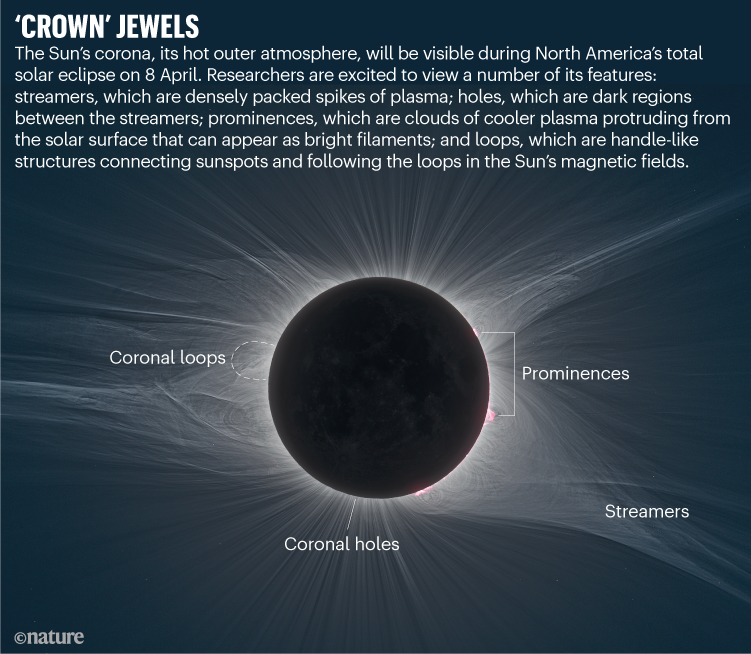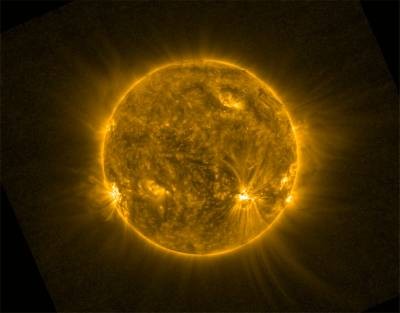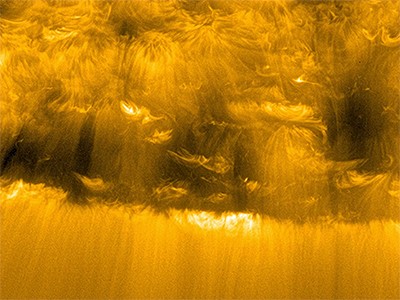Researchers in North America are gearing up for their chance to observe the Sun’s corona — its wispy outer atmosphere — like never before. Normally hidden to the naked eye by the Sun’s glare, the corona will be visible to millions from Sinaloa, Mexico, to Newfoundland, Canada, when the Moon blocks the solar disk during the total eclipse on 8 April. Importantly, the event coincides with the solar maximum — a period of extreme activity that occurs every 11 years. During this time, the Sun’s magnetic fields intensify, creating sunspots, fiery loops of plasma and exciting structures in the corona.
The Sun’s outer atmosphere, named for its crown-like appearance, is one of astronomy’s biggest unsolved mysteries, says James Klimchuk, a solar physicist at the NASA Goddard Spaceflight Center in Greenbelt, Maryland. For decades, scientists have been scratching their heads about why the corona, a hot plasma that extends millions of kilometres from the core, is so much hotter than the solar surface. “It’s like if you walk away from a campfire,” Klimchuk says, but instead of cooling down, you get warmer. “Why would that be?” They also have puzzled over what gives the corona its intricate structure (see ‘Crown jewels’).

Source: Nature adaptation from image provided by Nicolas Lefaudeux
Earth experiences total eclipses roughly once every 18 months. But their paths often cross remote areas, where few people can view them. The last time a total eclipse passed over North America was in 2017. Viewers along that eclipse’s ‘path of totality’ — in which the Moon completely blocks the solar disk — “wouldn’t have seen the same Sun as we’re seeing” during this one, says Marcel Corchado-Albelo, a solar physicist at the University of Colorado Boulder, who will participate in a public-outreach programme on 8 April aimed at marginalized communities in Texas. During the previous eclipse, the Sun was closer to its solar minimum.
The corona will “look much more complex” this time, Klimchuk says.
Simulating the Sun
A preview of how it might appear during the eclipse was released last month by Predictive Science, a research and product-development firm in San Diego, California. Staff members, including astrophysicist Cooper Downs, used real-time satellite data of the Sun’s surface magnetic fields and intensive supercomputer simulations to make the prediction. “The Sun is quite chaotic,” Downs says. So forecasting the corona’s appearance is as difficult as predicting cloud movement — the mention of which is a source of anxiety for eclipse chasers. Clouds could obscure the eclipse from the view of many on 8 April.
Staring at the Sun — close-up images from space rewrite solar science
The firm’s prediction shows a corona composed of several spiky, spade-like structures called streamers, in which coronal plasma is tightly confined by magnetic field lines that leave the Sun’s surface but loop back into it. Streamers glow brighter than other parts of the corona because electrons in the denser plasma scatter sunlight. The prediction also shows coronal holes, darker regions between the streamers where magnetic field lines don’t loop back into the Sun but extend into interplanetary space. The holes can create strong gusts of solar wind — charged particles accelerated by magnetic fields — that cause geomagnetic storms threatening Earth-orbiting satellites.
By comparing the locations of streamers and holes in the actual eclipse and the simulation, the firm’s scientists will be able to validate and improve their model for future applications, including space-weather forecasting, Downs says.
Photo op
Because the Moon perfectly blocks the solar disk during an eclipse — owing to the cosmic coincidence that the Sun and Moon have similar sizes when viewed from Earth — solar physicists on the ground, including Shadia Habbal at the University of Hawaii in Honolulu, will be able to study the Sun’s chromosphere next week. This thin layer of plasma just above the solar surface is home to prominences, worm-like filaments of plasma protruding into the corona. “You see them very clearly during an eclipse,” Habbal says.
Sometimes, these prominences can snap explosively to form a coronal mass ejection. During one of these events, billions of tonnes of relatively cool (about 10,000 °C) solar plasma are expelled from the solar surface and are enveloped by the corona, whose temperature can exceed 1,000,000 °C. Habbal says that because of the solar maximum, viewers have a good chance of seeing a coronal mass ejection. Eclipses provide “the best opportunity to figure out how these plasmas co-exist and interact”, she adds.
To do this, Habbal is leading a team of 40 researchers armed with high-speed cameras and high-resolution sensors to capture tiny changes in the corona during the eclipse’s minutes of darkness. The scientists will be spread across three sites in Texas and Arkansas, to maximize the chance of a cloudless observation.
Flying high
One group that is not worried about clouds is the Airborne Coronal Emission Surveyor (ACES) team. These scientists will fly in a Gulfstream V jet above the clouds, at an altitude exceeding 13 kilometres. This will put them over a layer of water vapour in Earth’s atmosphere that absorbs infrared light and would interfere with their measurements of the corona. Chad Madsen, an astrophysicist at the Harvard–Smithsonian Center for Astrophysics in Cambridge, Massachusetts, and an ACES participant, says the team is interested in studying one particularly long streamer in the Predictive Science forecast.
What powers the Sun’s mysterious wind? A daring spacecraft has some answers
The team will measure infrared light emitted by the streamer to determine the strength of the magnetic fields in the part of the corona where it appears and the makeup of ions along various segments of the streamer, Madsen says. (Magnetic fields in the corona directly affect the infrared light emitted by plasma.)
Their flight will chase the Moon’s shadow along the path of totality through Texas, adding 90 more seconds of observation time to the maximum of 4 minutes and 30 seconds that viewers on the ground will get.
For many corona scientists, this eclipse isn’t their first, and probably won’t be their last. But each one offers a few minutes of magic. “There’s always an anticipation — you don’t know what it’s going to look like,” says Habbal, who will count this as her twentieth total eclipse. “Every time, it’s different.”



